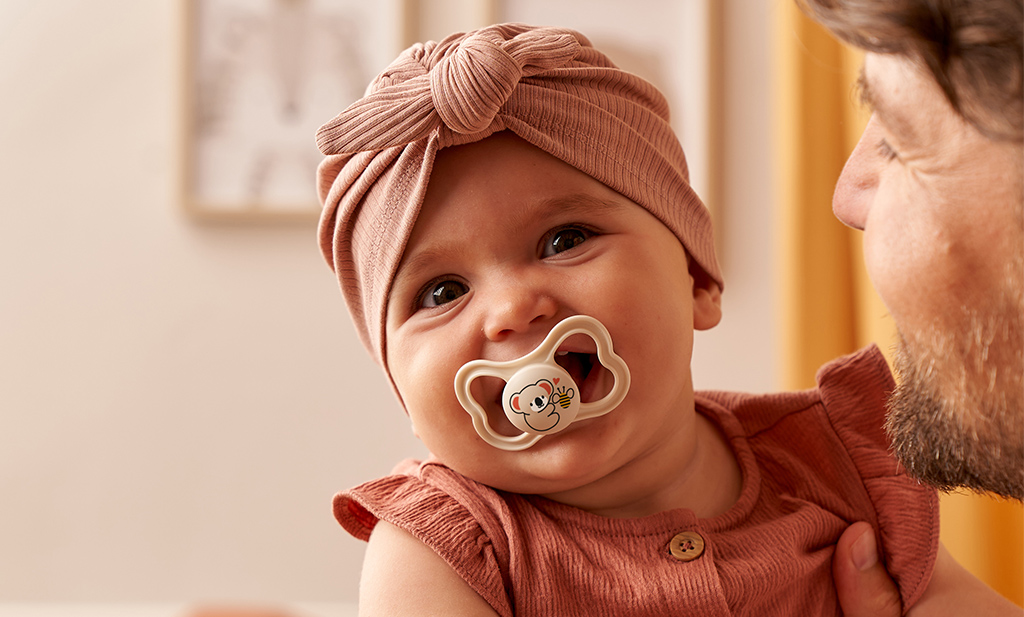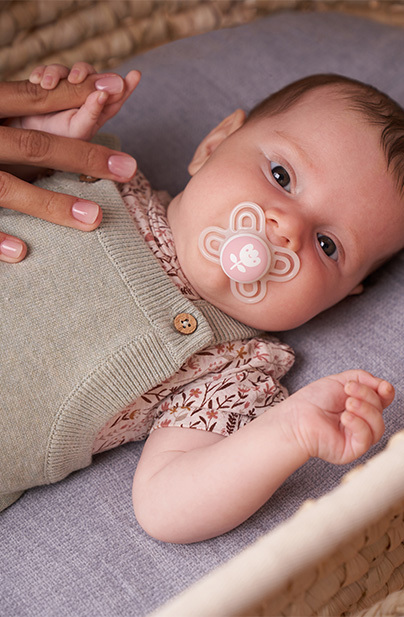
Have you ever wondered how newborn babies can intuitively suckle on their mother’s breast/chest? How can they do it so instinctively? It’s simple: sucking and suckling are innate behavioural mechanisms in young babies.
Even in the womb, growing babies can be observed sucking their thumbs during ultrasound examinations. According to scientific studies, sucking has a calming effect and can even help to reduce unpleasant or painful sensations. It’s no wonder that in some families a dummy is considered the “Holy Grail” that must not be lost under any circumstances.
But what about a dummy? Is it healthy for your little one’s teeth development? And if so, what does the perfect dummy look like? Or is it best not to teach your baby to suck on a dummy, because it is so difficult to wean off later? And what if your child prefers to suck their thumb rather than a dummy?
A dummy. Yes, or no?
When it comes down to it, the choice is entirely yours. Whether your baby is breast/chest, bottle fed or using a dummy or their thumb, your baby has a sucking reflex in every situation. They will continue to do so even without a dummy – whether it’s using a comforter, their fingers, or a cuddly toy. Sucking relaxes your baby. That’s why many children continue to suck on their mother’s breast/chest, even when their hunger has been satisfied, or use their mother’s breast/chest at night as a calming aid.
The advantages of using a dummy for baby.
You can satisfy your baby’s need to suck and at the same time aid them to self-regulation. In addition, the effects of dental malocclusions later are less with a dummy than if your child uses soothing toys, their thumb or other means of soothing instead.
It can be very exhausting for your body if your child sucks on your breast/chest for hours and demands the boob to calm themselves. That’s why many midwives recommend that you don’t start soothing your baby at night so your little one can get into a relaxed sleep rhythm.
The NHS states it is possible using a dummy at the start of sleep reduces the risk of SIDS (sudden infant death syndrome). But this evidence is not strong enough and not all experts agree that dummies should be promoted.
NHS guidelines also say, if you do use a dummy, do not start until breast/chest feeding is well established. This is usually when your baby is around one month old.
When to start giving a newborn a soother?
It’s best to ensure that your baby has gotten the hang of breast/chest feeding and/or formula feeding (by around 3 to 4 weeks old) before you introduce a pacifier. That’s because the sucking mechanism for breastfeeding is different from that used for sucking on a soother. You should also only give your baby a dummy when they are full, i.e., after breast/chestfeeding or formula feeding.
How to choose a dummy for baby?
One of the many confusing parts of new parenthood, could be trying to navigate the rather complex world of different dummy shapes and trying to figure out the best dummy for your newborn. Questions such as whether or not you would use one at all, What the different teat shapes are, and the differences in materials such as natural rubber dummies or silicone baby dummies. If you find yourself in the same boat, hopefully this section will help make things a little clearer for you and help you to make an informed decision in choosing which is the best dummy for your little one.
- Different materials: Baby dummies can be made from various materials including natural rubber, silicone or other soft plastics. The materials themselves have limited differences in the way in which they work to soothe baby. However, they are important in terms of both safety for baby and their environmental impact.
- BPA-free: Always BPA and phthalate-free for your ultimate reassurance.
- Correct size: The right dummy size is dependent of your child’s age. For this reason, it is important to change the dummy size after 6 and 18 months respectively. You can identify a too big dummy as the soft suction piece won’t fit properly into their mouth and the silicone or latex piece can still be seen. The change to a large dummy should be made during the day as you can keep an eye on the suction behaviour of your little treasure.
- Safety: It is very important that you make sure that the soother rests against your child’s face with a shield that is large enough so that your child cannot swallow it. In addition, the dummy must not obstruct breathing through the nose.
- Dust-free & easy to clean: Hygienic, anti-static properties help prevent dust from settling on the soother, so you know it’s safe to put in baby’s mouth.
- Light weight: the dummy should be light to minimise the strain on baby’s mouth, facial muscles and to stay put in baby’s mouth for longer, so you don’t need to replace it every few minutes.
- Orthodontically shaped: The dummy should have a flat shape so that your baby’s tongue can move freely in their mouth. A thin shaft is ideal to keep the distance between the upper and lower jaws small. An extra-thin neck (such as a MAM soother) allows your child to close their mouth naturally and reduces the risk of an open bite of the front teeth.
- Good ventilation: to minimise the build-up of moisture a dummy should have ventilation holes.
What to do when your baby’s dummy falls out at night.
Falling back asleep after a pacifier falls out is hard on everyone. It isn’t easy for your baby to find a lost pacifier in the dark, and going into their cot or bed repeatedly to retrieve it for them can prevent both of you from getting a good night’s sleep.
If the dummy falls out of your baby’s mouth during sleep, you don’t need to put it back in all the time.
You could try and teach your baby how to retrieve a pacifier on their own. Place a few extra pacifiers in the crib or bed with them, so they don’t need to reach far to find one and put it back in their mouth. Instead of putting the pacifier directly into their mouth, put it in their hand. The next time you go to help them, guide their hand to where the pacifier is in the crib, and let them do the rest.
Please do not tie or clip a pacifier to your baby or their crib with a rope, ribbon, or string. This is a major safety hazard—the pacifier shouldn’t be attached to anything.

Which is better – dummy or thumb sucking?
There are advantages to allowing your baby to suck their thumb rather than a dummy. But it’s fair to say that both can have their problems, particularly when it comes to giving up!
The main advantage of thumb-sucking is that your baby’s thumb is always there. It won’t fall on the floor. It doesn’t need to be sterilised. Best of all, your baby’s thumb is under her own control.
Your baby may even have started sucking their thumb before birth. Sucking is a natural reflex that babies use to calm and settle themselves. When your baby sucks on their thumb or finger, there is a greater chance of developing a pronounced overbite later. The reason for is that the finger is much thicker. This can lead to an open bite of the front teeth – just like with low-quality dummies that have a wide neck.
Dummies can be useful if your baby cries a lot and wants to suck something to soothe and calm themselves. It’ll give you a much-needed break too.
If you’re breast/chest feeding, it’s best to wait until your baby is at least a month old before giving them a dummy. Some experts believe that using a dummy may confuse a breast/chest fed baby, which may affect how they can latch.
Baby Centre explains experts think that sucking on a dummy reduces the amount of time your baby could be spending on your breast/chest. If your breasts/chest aren’t stimulated enough, your milk supply could go down. Frequent dummy use has been linked to an increased risk of ear infections too. You can reduce this risk by only giving your baby a dummy to help them settle to sleep.
How and when to start weaning your child off a dummy?
The Lullaby Trust recommends that parents stop giving a dummy to their baby between six and 12 months of age. This will help lower the possibility of longer-term problems that are sometimes associated with dummies, including ear infections and misalignment of teeth.
Of course, when faced with a distressed child this is easier said than done! Babies often use attachment objects, such as their thumbs, or security blankets, into their second year and beyond.
It may take some effort on your part to persuade your baby to part with their dummy. Many babies who go to sleep with a dummy will look for it when they wake up during the night. By removing it as a sleeping aid, your baby will learn to settle back to sleep by themself. There are tons of children’s story books available that are designed to support little ones as they give up their dummy which you can read together as part of your bedtime routine.
You can give your little one a new cuddly toy or a soft blanket to help comfort them in place of their dummy. Talk to them and tell them that they can swap their dummy for a lovely new toy.
You can be imaginative, toddlers love magical stories, so reading a story about the Dummy Fairy and how she’s going to come and give their dummy to the baby fairies will build excitement. And if the timing is right, you could hang their dummy on your Christmas tree for Santa to take or leave it out for the Easter bunny to swap for a treat.
Remember that the process of moving on from a dummy can be difficult and stressful for little ones and parents. Try not to put too much pressure on yourself (or them) and be patient – you’ll get there in the end!
Finding the right dummy for baby
As you have learned, your little darlings have an innate sucking reflex that needs to be satisfied. Try out what works best for you and your baby and, when deciding on a dummy (or not!), consider the above criteria mentioned.



